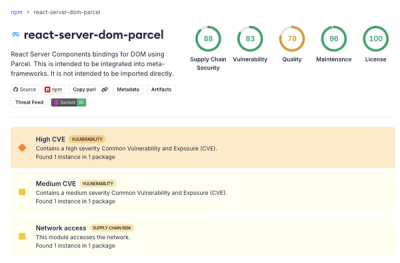
Security News
Deno 2.6 + Socket: Supply Chain Defense In Your CLI
Deno 2.6 introduces deno audit with a new --socket flag that plugs directly into Socket to bring supply chain security checks into the Deno CLI.
create-next-app
Advanced tools
The easiest way to get started with Next.js is by using create-next-app. This CLI tool enables you to quickly start building a new Next.js application, with everything set up for you. You can create a new app using the default Next.js template, or by using one of the official Next.js examples. To get started, use the following command:
You can create a new project interactively by running:
npx create-next-app@latest
# or
yarn create next-app
# or
pnpm create next-app
# or
bunx create-next-app
You will be asked for the name of your project, and then whether you want to create a TypeScript project:
✔ Would you like to use TypeScript? … No / Yes
Select Yes to install the necessary types/dependencies and create a new TS project.
You can also pass command line arguments to set up a new project
non-interactively. See create-next-app --help:
Usage: create-next-app [project-directory] [options]
Options:
-V, --version output the version number
--ts, --typescript
Initialize as a TypeScript project. (default)
--js, --javascript
Initialize as a JavaScript project.
--tailwind
Initialize with Tailwind CSS config. (default)
--eslint
Initialize with ESLint config.
--app
Initialize as an App Router project.
--src-dir
Initialize inside a `src/` directory.
--turbopack
Enable Turbopack by default for development.
--import-alias <alias-to-configure>
Specify import alias to use (default "@/*").
--empty
Initialize an empty project.
--use-npm
Explicitly tell the CLI to bootstrap the application using npm
--use-pnpm
Explicitly tell the CLI to bootstrap the application using pnpm
--use-yarn
Explicitly tell the CLI to bootstrap the application using Yarn
--use-bun
Explicitly tell the CLI to bootstrap the application using Bun
-e, --example [name]|[github-url]
An example to bootstrap the app with. You can use an example name
from the official Next.js repo or a GitHub URL. The URL can use
any branch and/or subdirectory
--example-path <path-to-example>
In a rare case, your GitHub URL might contain a branch name with
a slash (e.g. bug/fix-1) and the path to the example (e.g. foo/bar).
In this case, you must specify the path to the example separately:
--example-path foo/bar
--reset-preferences
Explicitly tell the CLI to reset any stored preferences
--skip-install
Explicitly tell the CLI to skip installing packages
--disable-git
Explicitly tell the CLI to skip initializing a git repository.
--yes
Use previous preferences or defaults for all options that were not
explicitly specified, without prompting.
-h, --help display help for command
create-next-app allows you to create a new Next.js app within seconds. It is officially maintained by the creators of Next.js, and includes a number of benefits:
npx create-next-app@latest (with no arguments) launches an interactive experience that guides you through setting up a project.npx create-next-app --example route-handlers).Create React App is a similar tool for bootstrapping React applications. It provides a default project structure, configuration, and scripts for building React applications. While create-next-app is tailored for Next.js, which includes server-side rendering and static site generation, Create React App is focused on client-side rendering.
Vue CLI is a command-line tool for scaffolding Vue.js projects. It offers a similar experience to create-next-app but for Vue.js applications. Vue CLI provides a range of templates and plugins to customize the project setup, whereas create-next-app is specifically designed for Next.js.
Angular CLI is a command-line interface for Angular applications. It helps in setting up a new Angular project with a default configuration, similar to create-next-app for Next.js. Angular CLI includes features like code generation, testing, and deployment, tailored for Angular applications.
FAQs
Create Next.js-powered React apps with one command
The npm package create-next-app receives a total of 239,821 weekly downloads. As such, create-next-app popularity was classified as popular.
We found that create-next-app demonstrated a healthy version release cadence and project activity because the last version was released less than a year ago. It has 3 open source maintainers collaborating on the project.
Did you know?

Socket for GitHub automatically highlights issues in each pull request and monitors the health of all your open source dependencies. Discover the contents of your packages and block harmful activity before you install or update your dependencies.

Security News
Deno 2.6 introduces deno audit with a new --socket flag that plugs directly into Socket to bring supply chain security checks into the Deno CLI.

Security News
New DoS and source code exposure bugs in React Server Components and Next.js: what’s affected and how to update safely.

Security News
Socket CEO Feross Aboukhadijeh joins Software Engineering Daily to discuss modern software supply chain attacks and rising AI-driven security risks.